 |
 |
DVARAVATI ART
Classification and Dating
The Dvaravati art can be classified into 3 periods as the following:
Early Dvaravati Period (6th – 7th century)
Middle Dvaravati Period (8th – 10th century)
Late Dvaravati Period (10th – 11th century)
Early Dvaravati Period (6th – 7th century)
In this period, Dvaravati art shows the influence of Indian art a great deal. The classification of the Buddha images from this period is based on the development of the artistic style. This early Dvaravati style may be the oldest Dvaravati art in Southeast Asia.
The art was influenced by Amaravati art (circa. The 1st – 4th century), Gupta art (circa. 4th – 6th century), late Gupta art (circa. 6th – 8th century), and was named after the dynasties that ruled south of India, e.g. Vakataka art. Most of the art objects belong to Theravada Buddhism.
The Buddha images which are considered to be Dvaravati art but still strictly followed the form and style of Indian art are the genre of standing Buddha images wearing thin transparent robes covering both shoulders. The robe covers the whole body and the hem of the robe is curvy at the ankle. The standing Buddha images are usually in the attitude of blessing, i.e. the right arms stretching along the body showing palm and the left hand holding the robe at chest height. These are the typical Gupta style. There are Buddha images, which are contemporary to those of Central Java and Pre-Angkor style.
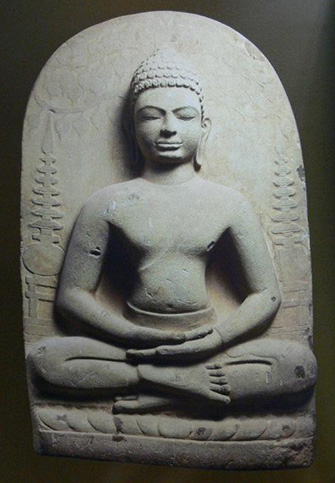
Buddha in Meditation, Early Dvaravati, ca. 8th - 10th century, Prachinburi National Museum
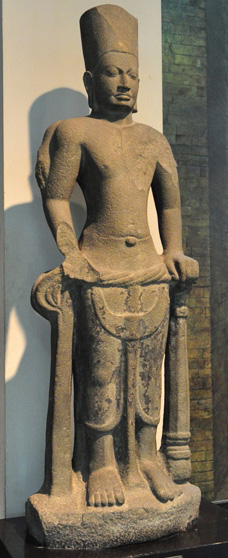
Vishnu, Early Dvaravati, ca. 7th - 8th century, National Museum Bangkok
Middle Dvaravati Period (8th – 10th century)
Dvaravati art from this period still followed Indian art concept and artistic values, but started to find its own style. Therefore. They could be referred as the genuine Dvaravati art, even though some of them were influenced by Java and Cham arts. The middle Dvaravati style was ubiquitous around the 8th – the 10th century and complimented as the golden age of Dvaravati art. The style is mainly based on Indian art and later mixed with the indigenous artistic preferences. Almost all of art objects from this period are Buddhist sculptures.
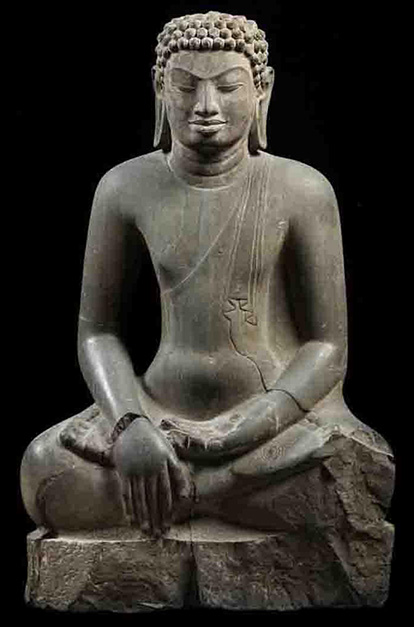
Buddha Subduing Mara, Middle Dvaravati, 8th century, National Museum Bangkok
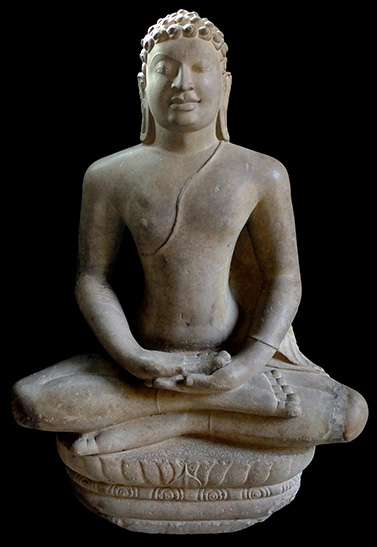
Buddha in Meditation, Middle Dvaravati, 9th - 10th century, my private collection
The major development from the early to middle period style are the standing position, from Tribhanga (triple flexion) standing to symmetrical standing, and attitudes of teaching, from one hand to both hands. The standing and the attitude of both hands in symmetry. In the attitude of preaching, the thumb and the index finger touches and makes a circle, the other three fingers may be upright of folded down. The upright fingers are found in the early Buddha images of the middle style.

Standing Buddha, Middle Dvaravati, ca. 8th - 9th century, National Museum Bangkok
Late Dvaravati Period (10th – 11th century)
In this period, Dvaravati art was in decline, so the excellent features from the Middle style made way to the influence of Khmer arts, which has come to Dvaravati states since the 10th century. The influence of Khmer art brought the variations to Dvaravati art, and each one was influenced by local preferences, which could be classified into the following.
i) Dvaravati Buddha images in central of Thailand (circa. 10th – 11th century)
This style had been developed from the Middle period, but because of the political power of Khmer and the decline of Dvaravati, the sculptures from this period were influenced by Khmer art a great deal, thus making the style of the sculptures mixed by two great cultures.
There were many major changes on the Buddha images. The face is extended longer than the Middle style with the wider forehead, and narrow chin. The hair curls are small and spike-like. The eyebrow is connected and district. The eyes protrude and were made in deep hole so that the images look revered. The mouth is split and the lips are thick. Some of the Buddha images appear to have moustache or lines above the mouth showing moustache. This idea may have been brought from the Khmer sculptures since the 9th century.

Standing Buddha Vitarkamurdra, 10th - 11th century, Chao Sam Phraya National Museum
ii) Dvaravati Buddha images in the northeast of Thailand (I-San)
Dvaravati in I-San can be classified into 2 groups.
The former group has similar style to those created in central Thailand. This group of Buddha images was created in south of I-San, e.g. Nakhon Rachasima and Buriram province.
In the north of I-San, the Buddha images were influenced by local styles and preferences. The works found during the 8th – 9th century are small bronze statues, the image shows the influence of Amaravati, Gupta and Post-Gupta, i.e. the left hand holds the robe at the chest height.
The latter group was influenced by Pala art of India, which may have come to Thailand between the 9th – the 10th century. The sample is the Buddha image found in Kalasin province. The image is in the attitude of subduing Mara sitting cross-legs on the lotus-pedal platform. The face is round with lotus bud halo.
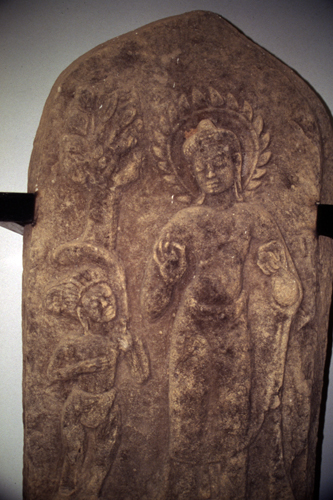
Boundary Stone, Khonkaen National Museum
Reference:
Department of Fine Arts. Dvaravati Art : The Early Buddhist Art of Thailand. Bangkok, 2009.
|
 |
|